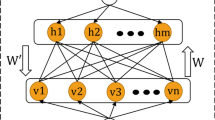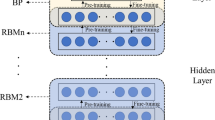Abstract
Surface roughness is a crucial factor affecting the surface quality of workpieces in manufacturing industries. Thus, it is important to provide an accurate performance of surface roughness prediction and optimal parameters to reduce the burden of time and costs during the process. In this study, two predict models, namely multiple linear regression and deep belief network (DBN) models, were performed to accurately predict change in surface roughness in the rotational electromagnetic finishing (REMF). Compared to the statistical-based model, the data-driven model based on the DBN architecture was a significantly considerable effect on surface roughness prediction in the REMF process. Among the considered DBN models, DBN5 architecture as [7, 14, 14, 1] showed effective features of the nonlinear relationship between process parameters and response with the highest determination coefficient (R2) of 0.9340 and the lowest mean squared error (MSE) of 1.3037 \(\times\) 10−3 in the testing datasets. In addition, a genetic algorithm (GA) as a heuristic optimization technique was adopted to optimize the input parameters of the best derived DBN model. It showed that the maximum change in surface roughness was 0.530 at particle length of 3 mm, particle diameter of 0.7 mm, particle weight of 1.3 kg, liquid water quantity of 1.0 l, a rotational speed of 1323 rpm, working time of 35 min, and initial surface roughness of 2.5478 m\(\upmu\).











Similar content being viewed by others
Availability of data and material
All the data supporting the results of this study were available within the article.
References
Prakash C, Singh S, Pramanik A, Basak A, Królczyk G, Bogdan-Chudy M, Wu YL, Zheng HY (2021) Experimental investigation into nano-finishing of β-TNTZ alloy using magnetorheological fluid magnetic abrasive finishing process for orthopedic applications. J of Materials Research and Technol 11:600–617. https://doi.org/10.1016/j.jmrt.2021.01.046
Cao L, Sendur K (2019) Surface roughness effects on the broadband reflection for refractory metals and polar dielectrics. Materials 12(19):3090. https://doi.org/10.3390/ma12193090
Arora K, Singh AK (2021) Theoretical and experimental investigation on surface roughness of straight bevel gears using a novel magnetorheological finishing process. Wear 476:203693. https://doi.org/10.1016/j.wear.2021.203693
Ahmad S, Singari RM, Mishra RS (2020) Modelling and optimisation of magnetic abrasive finishing process based on a non-orthogonal array with ANN-GA approach. Transactions of the IMF 98(4):186–198. https://doi.org/10.1080/00202967.2020.1776966
Xing B, Zou Y (2020) Investigation of finishing aluminum alloy A5052 using the magnetic abrasive finishing combined with electrolytic process. Machines 8(4):78. https://doi.org/10.3390/machines8040078
Singh M, Singh AK (2021) Magnetorheological finishing of variable diametric external surface of the tapered cylindrical workpieces for functionality improvement. J of Manuf Processes 61:153–172. https://doi.org/10.1016/j.jmapro.2020.10.074
Sirwal SA, Singh AK, Paswan SK (2020) Experimental analysis of magnetorheological finishing of blind hole surfaces using permanent magnet designed tools. J of the Brazilian Society of Mech Sci and Eng 42(3):1–23. https://doi.org/10.1007/s40430-020-2225-6
Nagdeve L, Jain VK, Ramkumar J (2020) Optimization of process parameters in nano-finishing of Co-Cr-Mo alloy knee joint. Materials and Manuf Processes 35(9):985–992. https://doi.org/10.1080/10426914.2020.1750633
Misra A, Pandey PM, Dixit US, Roy A, Silberschmidt VV (2019) Multi-objective optimization of ultrasonic-assisted magnetic abrasive finishing process. Int J of Adv Manuf Technol 101(5):1661–1670. https://doi.org/10.1007/s00170-018-3060-0
Li C, Wu Y, Li X, Ma L, Zhang F, Huang H (2020) Deformation characteristics and surface generation modelling of crack-free grinding of GGG single crystals. J Mater Process Technol 279:116577. https://doi.org/10.1016/j.jmatprotec.2019.116577
Li C, Piao Y, Meng B, Hu Y, Li L, Zhang F (2022) Phase transition and plastic deformation mechanisms induced by self-rotating grinding of GaN single crystals. Int Journal of Machine Tools and Manuf 172:103827. https://doi.org/10.1016/j.ijmachtools.2021.103827
Ahmad S, Gangwar S, Yadav PC, Singh DK (2017) Optimization of process parameters affecting surface roughness in magnetic abrasive finishing process. Materials and Manuf Processes 32(15):1723–1729. https://doi.org/10.1080/10426914.2017.1279307
Chen Y, Jin Y, Jiri G (2018) Predicting tool wear with multi-sensor data using deep belief networks. Int J of Adv Manuf Technol 99(5):1917–1926. https://doi.org/10.1007/s00170-018-2571-z
Vasanth XA, Paul PS, Varadarajan AS (2020) A neural network model to predict surface roughness during turning of hardened SS410 steel. Int J of System Assurance Eng and Management 11(3):704–715. https://doi.org/10.1007/s13198-020-00986-9
Hao X, Guo T, Huang G, Shi X, Zhao Y, Yang Y (2020) Energy consumption prediction in cement calcination process: a method of deep belief network with sliding window. Energy 207:118256. https://doi.org/10.1016/j.energy.2020.118256
Peng B, Bergs T, Schraknepper D, Klocke F, Döbbeler B (2019) A hybrid approach using machine learning to predict the cutting forces under consideration of the tool wear. Procedia Cirp 82:302–307. https://doi.org/10.1016/j.procir.2019.04.031
Ahmad S, Singari RM, Mishra RS (2021) Tri-objective constrained optimization of pulsating DC sourced magnetic abrasive finishing process parameters using artificial neural network and genetic algorithm. Materials and Manuf Processes 36(7):843–857. https://doi.org/10.1080/10426914.2020.1866196
Singh RK, Gangwar S, Singh DK, Pathak VK (2019) A novel hybridization of artificial neural network and moth-flame optimization (ANN–MFO) for multi-objective optimization in magnetic abrasive finishing of aluminium 6060. J of the Brazilian Society of Mechanical Sci and Eng 41(6):1–19. https://doi.org/10.1007/s40430-019-1778-8
Koopialipoor M, Tootoonchi H, Armaghani DJ, Mohamad ET, Hedayat A (2019) Application of deep neural networks in predicting the penetration rate of tunnel boring machines. Bull Eng Geol Env 78(8):6347–6360. https://doi.org/10.1007/s10064-019-01538-7
Stojanović B, Vencl A, Bobić I, Miladinović S, Skerlić J (2018) Experimental optimisation of the tribological behaviour of Al/SiC/Gr hybrid composites based on Taguchi’s method and artificial neural network. J of the Brazilian Society of Mech Sci and Eng 40(6):1–14. https://doi.org/10.1007/s40430-018-1237-y
Author information
Authors and Affiliations
Contributions
LJH and SYS performed experiments and data analysis. In addition, they contributed to writing the paper. KJS supervised the project and reviewed the paper.
Corresponding author
Ethics declarations
Ethics approval
Not applicable.
Consent to participate
Not applicable.
Consent for publication
All authors gave consent for publication.
Conflict of interest
The authors declare no competing interests.
Additional information
Publisher's Note
Springer Nature remains neutral with regard to jurisdictional claims in published maps and institutional affiliations.
Rights and permissions
About this article
Cite this article
Lee, JH., Seo, YS. & Kwak, JS. Surface roughness prediction and optimization in the REMF process using an integrated DBN-GA approach. Int J Adv Manuf Technol 121, 5931–5942 (2022). https://doi.org/10.1007/s00170-022-09652-9
Received:
Accepted:
Published:
Issue Date:
DOI: https://doi.org/10.1007/s00170-022-09652-9




